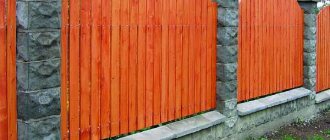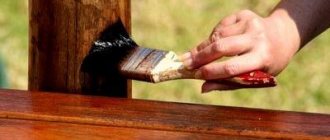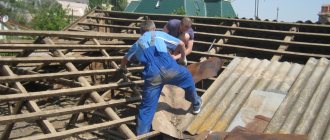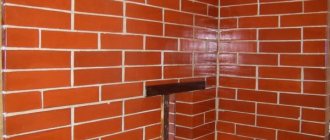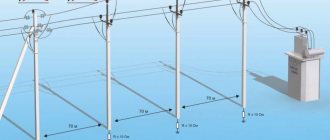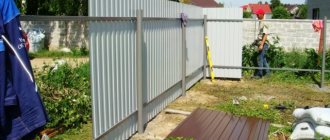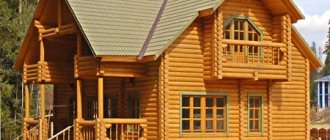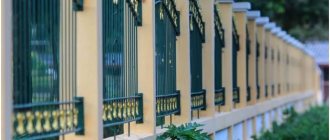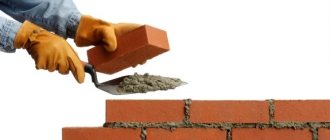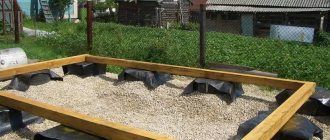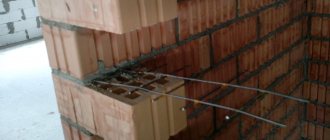The combination of stable and durable brick pillars filled with spans made of profiled sheets, metal picket fences, welded or forged sections is the most optimal option for fencing the site. Such a fence looks solid, and the costs of its arrangement will be significantly lower than when building a completely brick fence.
Constructing brick fence posts with your own hands is not a complex task, but it allows you to save significant money. It is only important to follow construction technology and use high-quality materials.
Preparation and calculations
When planning to build brick fence posts with your own hands, you must keep in mind that seemingly simple posts have a complex internal frame that ensures the stability and strength of the entire fence structure. The first step is to determine the features of the future structure and its overall dimensions.
By choosing the standard size of the interval between pillars, equal to 2 meters, and one and a half masonry, you can imagine how many bricks are needed for a pillar. The initial stage of preparation is marking the territory. The location of the future fence is cleared of plants to lay a ditch under the foundation. Considering the distance between the supports, calculating the volume of material is easy. You can save a lot if you put solid brick in the first three rows and make the subsequent ones hollow.
Choosing a brick: which one is better
Every builder strives to make the brickwork of fence posts look beautiful, but special attention should also be paid to the practical side. How the fence will perform its functions is determined by the material. For example, if fence posts are made of facing brick, then after a while it will crumble and lose its layers. We list the most common types of bricks.
- Ceramic ordinary brick. It is produced in two types: solid and hollow. The first option is durable, but too heavy. The second is characterized by light weight but low strength. The material has an affordable price; it will look better externally under the cladding.
- Clinker. It has high strength characteristics and does not crumble. Clinker is beautiful and has many textures. Looks harmonious next to any style of building. The price is much more expensive than facing bricks.
- Silicate. Has noise absorption properties. It is not affected by temperatures and does not lose its performance in frosts and high humidity. Eco-friendly and expensive.
Nowadays, “torn stone” called “Rock” is popular, which is used, among other things, for cladding facades and fences. “Skala” has exceptional characteristics and is successfully used in the construction of fences.
Calculation of the dimensions of brick pillars
Before you build brick fence posts with your own hands, you need to accurately determine their dimensions. Having included in the project a pillar height of 2 meters, its size is calculated based on the standard brick thickness (0.065 meters). The number of rows to be laid in one support is counted: its height (2 m) is divided by the thickness of the brick. The result is the number of rows (30.7), not counting the thickness of the solution. The amount of brick depends on the technique that the mason will follow. A row of support, laid out in one and a half bricks, consists of four parts, and in two - from six. Assuming the thickness of the seams to be 1 cm, subtract this figure from the result obtained:
- 30 seams × 1 cm = 0.3 m;
- 2 m – 0.3 m = 1.7 m.
The figure is divided by the thickness of the brick (1.7 m: 0.065 m) to obtain the entire material - this is the actual size of the pillar of 26 rows. By multiplying this figure by the number of bricks in the row, the number of all bricks is determined. Bricklaying methods are important here too. A masonry of 1.5 bricks will require 26 × 4 = 104 pcs., and a masonry of two - 26 × 6 = 156 pcs. In addition, you should always make a reserve for defects and broken materials (5% - 5 bricks).
Estimated cost
After weighing all the possible costs of building brick supports for a fence, the cost of the project is determined. This includes materials, aids, tools and wages for the hired crew. If you decide to build a fence yourself, the savings can be 35-40%. The total price of a fence with brick pillars depends on the following items:
- quantity of materials;
- dimensions of the fence (length, height of supports);
- shape of support pillars;
- masonry method.
Brick prices vary widely. The cost of simple facing bricks starts from 18 rubles per piece. Hand-molded material can cost from 73 to 97 rubles per piece. A standard fence with brick pillars will cost the owner 8,500 rubles and more. The price includes the price of laying the support (brick + mortar + fittings or pipe). If we count in linear meters, installation of a fence will exceed 7,000 rubles. It is more profitable to build the fence yourself.
Mortgages for fastening fence sections
Pre-prepared embedded elements in brick fence posts
The type of mortgages depends on what the fence sections will be made from in the future. If it is brickwork, then the role of the mortgages is reduced to connecting the pillars and sections into one whole. Since there will not be any special weight load on them, it is enough to use wire loops 8 mm thick, laid in every fourth row on the side of the post to which the sections will be attached.
If the sections are made of corrugated sheets, wooden beams, and so on, that is, they will be attached only to poles, stronger mortgages are needed that can withstand their weight. In this case, metal plates are used that are welded at a certain height (or mounted in any other way) to the base pillar, and the brick is cut in the right place using a grinder.
In the future, logs will be welded to the mortgages, and corrugated sheets, metal rods and other elements will be mounted on them.
All is ready? Don’t rush to fasten the fence sections right away - the posts should stand for about three weeks, otherwise you can easily ruin all the work. In the meantime, there is time to think.
Where to start working
To ensure straightness, the marking cord is pulled. The foundation is selected. A fence made of corrugated sheets or wood will stand well on a pile foundation.
A mason needs to stock up on the necessary equipment. These include:
- trowel - a tool for applying mortar to brick;
- shovel for loading the solution;
- level, plumb line, string for tracking horizontal and vertical;
- pickaxe - a hammer with a pointed end for breaking off part of a brick;
- grinder - allows you to cut material or make grooves.
Foundation for a fence with brick pillars
Installation of any type of fence with brick pillars requires a foundation. For a light fence made of wood or mesh, one foundation is selected, but for a fence that has significant weight, a different type is required, for a larger load. Soil composition, groundwater depth and freezing are important. If the soils are mainly clayey, heaving, and groundwater is located high, the holes for the piles should be deepened 20-25 cm below the freezing level.
Tape
If the fence is made of brickwork between pillars or other massive materials, then a strip foundation must be used to install and ensure its stability. A trench is dug under it, and holes with a diameter of 15-20 cm are drilled in the places where the pillars are installed. First, concrete is poured into the wells with pillar posts installed in them. After this, layer-by-layer concreting of the trench begins. A trench 20-30 cm deep is dug along the entire proposed perimeter of the fence. The foundation parameters (overall dimensions of the trench, reinforcement, backfill depth) are determined based on the strength characteristics:
- the trench has a depth of 20-30 cm;
- the depth of the hole for the pillars is 90-100 cm from the surface;
- foundation height above the surface – 40-60 cm;
- width – 20-35 cm;
- distance between supports – 2.5-3.5 m;
- height of supports – up to 180 cm (masonry cross-section 38×38 cm).
If there are unstable soils on the site, before pouring the foundation, lay reinforcement bars (4-6 pieces, diameter 14-18 cm). We install the support no earlier than 2-3 weeks after laying the foundation, laying waterproofing under the bottom of the pillars.
Columnar
Columnar foundations are made on highly heaving, freezing soils. Such foundations are well resistant to squeezing out of the structure in winter. To build the described foundation, the following procedure is followed:
- mark the location of the pillars;
- arrange nests for supports with a sand and gravel cushion;
- tamp the pillow strictly vertically, using a level;
- Fill the supports with mortar.
The foundation does not require a large amount of materials, is easy to build and has a relatively low cost.
Stone
A stone foundation is made from natural or “ragged” stone. It has high strength indicators and is very reliable. However, this type of foundation is rarely used, since it does not harmonize with all types of fences. It looks good with wrought iron and brick fences. The construction of a stone foundation is complicated by its large weight, which may require additional equipment. If such a foundation is being built, you need to prepare the following materials:
- stone selected according to shape and size;
- mortar with cement for fastening elements;
- twine and pegs for marking the trench;
- crushed stone;
- tools (shovels - shovels and bayonets).
Foundation installation
Since the mass of brick pillars is significant, it is necessary to pour a strong strip foundation. All work must be performed using appropriate technology.
First, holes are dug for mounting two supports. The depth depends on the level of soil freezing. This value will be different in each region.
The next step is to make a pillow, which includes sand and crushed stone. First, sand is poured, the thickness of the layer should exceed five centimeters. It is compacted well. A 15 cm layer of crushed stone is poured on top, which is also compacted.
A frame is made using reinforcing bars. They are laid in horizontal and vertical directions. They are tied with knitting wire, maintaining a step of 20 cm. Then the reinforcement frame is inserted into the hole made. After that, the installation of steel pipes is carried out, playing the role of the supporting frame of all brick pillars. Installation work must be carried out level, after which the pipes are well secured.
A concrete solution is prepared, for which it is necessary to pour the following into a concrete mixer:
- cement;
- sand;
- crushed stone
All components are mixed very thoroughly. Water is added to the mixture and mixed until a concrete mixture is obtained.
The process of pouring the foundation for the gate
The resulting solution must be concreted into the pits with pillars and wait several days until the concrete has completely hardened. Installation of the pillars can begin after the foundation has completely dried, but not earlier than half a month.
Preparatory work and marking
Having cleared the space from vegetation, they begin marking. To do this you will need pegs and rope. Start with the corners of the future structure. Taking into account the characteristics of the soil, holes of the required depth are prepared for the intended location of future pillars. The laying of any brick pillar will begin only after the technological readiness of the foundation. In the meantime, you should carefully check the material. The brick for construction has already been selected and must meet the following qualities:
- strength. The main requirement for a support is its resistance to external factors: wind, rain, temperature changes;
- long service life. A fence with brick pillars, built in accordance with technology, will really last a long time;
- some types of decorative pillars made of hollow bricks are light in weight, which is an advantage during installation and when choosing a foundation;
- attractive appearance of the brick structure.
Solution: what proportions should be
The composition of the mixture plays an important role in ensuring the strength of the future structure. Its density and density are of great importance for work. To prepare the solution, you should use high-grade cement (at least M-400), and fine sand.
To prepare the mixture you will need a container (bucket, vat). The proportions of the components are 1:5 (cement: sand). To ensure plasticity, many craftsmen add liquid soap or dishwashing detergent (20-30 grams per bucket). According to the technology, in order to give the specified quality to the substance, lime is added (1 part). There is a “folk” method to check the quality of the solution. The prepared mass is applied to a plane, and a cross is drawn on it. Then the formation is taken to the trowel. If the cross does not move, this indicates the desired consistency of the solution. The decorative quality of the pillar increases significantly if soot is added to the mixture, which gives it a black color, which looks original.
Design Features
For sliding gates
When installing sliding gates, there is no point in looking for drawings of the embedded elements, they simply do not exist. The geometry and dimensions are chosen arbitrarily, because only one task must be solved: creating a base for installing rollers and a drive mechanism. Typically, mortgages are made from channels numbered 10-20. There is a clear rule here: the weight of the gate increases - larger rolled metal is required.
Keep in mind that space for the engine must be provided behind this line in the yard. To avoid mistakes, it is worth making the embedded element equal in length to the “counterweight” of the gate.
Sometimes it can be smaller, but a maximum of 20 cm. If you plan to later install a drive with an electric motor, the platform for its installation is welded to the mortgage in a randomly selected location. But some builders do things differently. At the time of construction of the gate, they do not prepare any basis for the motor. Only then, when it is being installed, is a steel plate that extends slightly to the side welded onto the top of the mortgage.
For the gate
The approach to such mortgages is somewhat different than to the elements holding sliding gates. There is no need to insert the rods inside the brick pillars. It is necessary to place them directly next to the supports, driving them into the ground. When this work is completed, the channel is welded.
Since wickets are much lighter than regular gates, the hinges should not be too massive either. But it is recommended to bury the supports into the soil, then they will be more reliable.
For large gates with high posts, it is not enough to install vertical channels near both halves. At the bottom they are fastened with a third channel, the length of which should coincide with the distance from the pillars to the gate.
You can often come across statements that it is possible to weld embeds to steel strips protruding from the pillars. But in reality, these miniature protrusions will not be able to hold even a small gate. In the case of swing gates, metal mortgages measuring from 5 to 7 cm are welded to the central posts of the pillars. This is quite enough for automatic structures, if they do not turn out to be too heavy.
Additional recommendations for selection and installation:
- For heavy swing gates, I-beams or rails can be welded between the posts. It will be safer if you do this with braces and weld additional beams on the other side.
- If you lack experience, it is better not to try to hide mortgages and then bring them out; this is extremely difficult.
- It is more correct to hammer (screw in) a metal product through a hole prepared with a special tool.
- Holes in the brick are made at an angle of 45 degrees (deviation is acceptable, but small, otherwise the brick will crack).
How to make mortgages with your own hands, see the video below.
Let's block ads! (Why?)
Laying fence posts: basic technologies
Typically, the pillars are 1.5-2 m high and 38×38 cm or 51×51 cm wide (for three-meter supports). Strength is achieved by the method of laying bricks. The seam between the bricks (8-10 cm) of the bottom row should overlap the surface of the top brick. This masonry scheme ensures that the rows are connected to each other.
Operating procedure
To correctly assemble a brick pillar yourself, you need to follow the following procedure.
- Laying waterproofing under the support so that it does not become saturated with moisture. The wet brick begins to deteriorate. For insulation, roofing felt or special insulation with bitumen (“Gidroizol”) and mastic are used.
- Each layer is checked with a level. Use the handle of a trowel, tapping it on the masonry. You must also have other devices for laying brick pillars - a hammer with a rubber tip and others.
- It happens that poorly wiped mortar drips onto the brick. It is recommended to lightly moisten the material with water. This makes it easier to clean the brick.
- After laying out several layers, measurements are taken. By tapping with a hammer, displacements (even 1-2 mm) are corrected. Fill vertical gaps with mortar.
- The voids between the pipe and the masonry are filled with mortar; if it is large, crushed stone is mixed with sand, poured into the voids and secured with mortar.
Laying brick pillars under rods
Masonry with rods allows the mason to make beautiful seams, since usually excess mixture crawls out onto the plane of the brick, and the seams are made uneven. The rod (side - from 8 to 10 mm) is cut into pieces that are 10-15 cm larger than the pillar. Lay the first row, then the rod is laid along the edge. A layer of mortar and bricks of the second row are applied. The metal prevents them from sagging. A trowel is moved along the rod, removing excess. Bricks are checked by level. The same method applies when laying the rod on its side. The solution is applied with a trowel, the excess is also removed, a level is applied, and the workpiece is removed. The rod is removed and the seam is held in place with a trowel.
Installation of mortgages for fastening fence sections
The master often misses a detail - what to attach the fence to. For fastening to the pipes in the middle of the column, embedded parts (angles, studs, etc.) are welded at the same height so that the crossbars stand level. For a solid brick wall, use 8 cm thick wire loops for every fourth row. In the case of corrugated sheets and wood, a cut is made in the brick and metal plates are attached to support the weight of the blade. Logs are welded onto the mortgages to secure the fence.
About the finials
Caps for protecting the masonry of brick fence supports
Here it is, your first DIY brick pillar! It is perfectly smooth, with seams of the same width, made according to all the rules - a sight for sore eyes! In order for it to remain that way for many years, the final touch is needed - a finial, which performs several functions at once:
- Protects the brick from excess moisture, which will destroy it when frozen.
- Protects concrete and metal base pipes located in the middle of the column. If they are not protected, then during rains the concrete will gradually crumble, and water, accumulating in the resulting depressions, will sooner or later reach the metal base.
- And finally, the pommel gives the post a more attractive, finished look, serving as its decoration.
For brick pillars, metal caps are usually used, the size of which is selected so that they protrude several centimeters beyond the boundaries of the pillar. When choosing them, give preference to products without rivets, with well-processed tight joints that can provide reliable protection. In addition, the following requirements are imposed on the pommels:
- resistance to precipitation;
- sufficient angle of inclination to prevent moisture accumulation;
- Possibility of reliable and accurate fastening to the pole;
- the presence of ventilation to prevent the formation of condensation.
And one more piece of advice to those who take on laying a brick pillar with their own hands: do not be overconfident! At first, not everything will work out for you; experience will only appear over time. In the meantime, start with the farthest, most inconspicuous pillar, even if it is not very successful, no one will notice it. But, having built it, you will gain dexterity, and in the future you will not repeat your mistakes.
DIY brick fence post. Underwater rocks
Beginner masons face a number of problems:
- the evenness of the first row of bricks, on which the appearance of the entire structure depends. A stretched horizontal thread should be used 2-3 cm above the masonry;
- horizontal and vertical masonry. Each brick must be checked with a level, they all must be at right angles to each other;
- beautiful seam. The pillar looks untidy due to unwashed mortar. When laying with a rod, it should be wiped off;
- bricks stained with mortar are cleaned immediately;
- mortgages are not provided. There is nothing to fasten the fence cloth to.
Advice from professionals
A few tips on doing masonry will help you do it well even for a novice master:
To ensure that the seams between the rows of bricks are of the same thickness, a metal rod of the required diameter is laid along the edge. The cement mortar is leveled over it, bricks are laid on top, tapped with a rubber hammer, then the rod is removed and laid on the next row.
- To maintain the perpendicularity of the corners, it is worth using a metal corner. Such a corner is attached to the seam with self-tapping screws and moved higher through several rows of masonry. The building level must be applied to all sides of the pillar; it is better to have two levels and measure adjacent sides along them to avoid twisting of the masonry.
- For beginners, it will not be easy to immediately achieve the required quality of brickwork, but after making one column, you need to take into account the mistakes and then the work will go faster. By laying out the posts yourself, you can save a lot and add more decorative details.
Common methods of processing and protecting seams
The masonry of a finished brick pillar will look more beautiful if the seams are treated as follows.
- Rectangular undercut. It consists of removing excess mortar with a trowel and treating with a stiff brush or lint.
- Rectangular recessed. It consists of removing part of the mortar from the seam (5-6 mm) and compacting and smoothing it with a round dowel. The use of such treatment protects the masonry from natural manifestations.
- Beveled jointing. Used in harsh climates. Using a sharpened trowel at an acute angle, cut the mortar to a depth of 3-4 mm.
List of materials
First, we list what materials and tools you will need:
- decorative or red brick, it is better to take a new whole one;
- cement mortar of a grade not lower than M400;
- a metal pillar around which the brick one will be built;
- gas drill or hand drill, shovel;
- crushed stone and sand for butting;
- metal rods 8 × 8 mm;
- plumb and level so that everything is smooth and beautiful;
- grinder, welding machine and rubber hammer;
- trowel - a spatula for applying the solution;
- mortgages, on which the fence itself will then be attached.
A natural question arises: what about the number of bricks per fence post? Below we will tell you how to make the calculations, but on average you will need 128–132 pieces per support. It is better to take a little more so as not to interrupt construction if there is not enough.
Fence caps
The final element of the pillars are caps, which provide the building with protection from precipitation. Manufacturers offer caps from various materials and different designs.
Concrete
They consist of an umbrella-shaped upper part protruding beyond the boundaries of the support. Moisture does not fall on the support, flowing down. The lower part of the cap is attached to the support. Products are produced in concrete colors and with the addition of colored pigment. They don't burn out.
Metal
The caps are made of galvanized steel. They can be a simple lid, or they can look like a pyramid. Similar products can be made from tin on your own site. Manufacturers are now offering innovative caps made from composite materials and alloys. They are distinguished by their slim design, elegance and reliability.
Installation of posts for gates that are locked with a bolt or a heavy gate
Installing gate posts to prevent them from moving can only be done by making a reliable foundation and ensuring their rigid connection with each other. Communication can be made at two points - at the bottom of the entrance, at the crossing through the gate and at the top of the pillars. Usually they are welded together at these two points, placing two I-beams between them.
But for the top fasteners there is a rather serious limitation - sometimes it may be necessary to pass vehicles that exceed the height of the dimensions of the pillars and the top beam. Therefore, the latter is made removable.
When installing an entrance to your own site, when you plan to drive only your own car, it is quite possible not to make a solid foundation for the gate, but to make separate ones for each post. In this case, they simply weld the pillars at the bottom with a thick I-beam, and on top they make the same beam, but removable, inserted into welded sockets and having welded pins for insertion.
However, this does not negate the laying of the foundation for each pillar separately, which should go below the freezing depth for such gates. A concrete pad is usually made at the entrance area. It will be very good if the I-beam, which is welded between the pillars below, is thicker than it. In a layer of concrete it will be reliably protected from rust, since concrete produces a slightly alkaline reaction and prevents metal oxidation.
The foundation is usually poured solid. Its depth should be below the freezing depth. Everything is done according to the same rules as the construction of a strip foundation for a house. The thickness of the foundation grillage is about 50 cm. Theoretically, 30 will be enough, but a width of 50 allows you to save on formwork and pour the foundation into a spacer with the walls of the trench.
Near the pillars, extensions-buttresses are made in both directions, perpendicular to the entrance. Usually, even for heavy gates, a buttress in the area of a post with a total length of one meter is sufficient. The foundation is reinforced before pouring.
It is advisable to install an I-beam at the top of the pillars. Considering that, usually, heavy gates require large and heavy posts, the beam must match.
It will be difficult to remove and replace it - you will have to bring in a crane each time. Therefore, it is better to immediately put a significant height reserve in the pillars and simply tightly weld the beam to them, once and for all.
Types of bricks
The lifespan of a fence is influenced by the quality, type of material, correct sequence of work, and compliance with building codes.
The most popular among the varieties of this material are the following options:
- Classic red brick. It is quite durable, its cost is from 8 rubles / piece. But it needs a protective coating, such as plaster. This prevents delamination and cracking of the brick (it is worth considering that the appearance of the coated fence itself can either gain or lose its attractiveness).
- Facing. More durable than standard red. A clear advantage is the decorative imitation of different materials.
- Frost-resistant. The strongest and most durable type. It tolerates adverse weather conditions and external influences well. Its cost is from 14 rubles/piece.
Installation diagram
